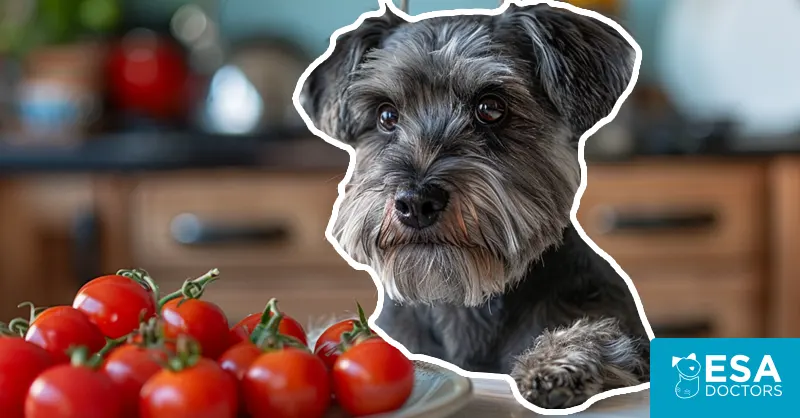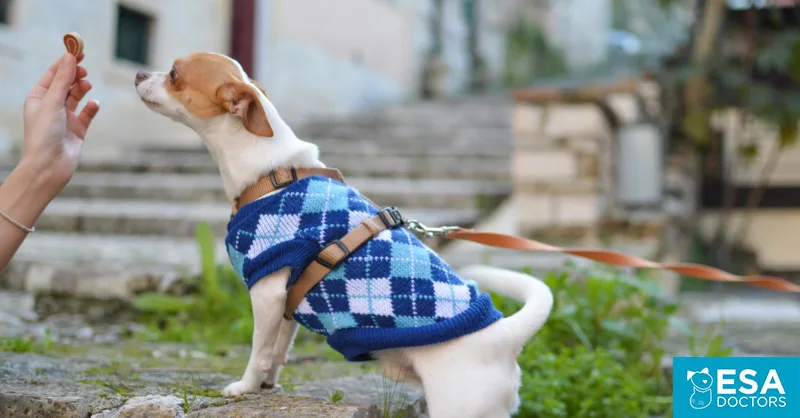Tomatoes are safe for dogs to eat when they are ripe and red. The actual ripened tomato fruit is considered non-toxic and contains multiple dog-healthy nutrients, including potassium, vitamins A and C, and fiber. Ripe and red are the keys to knowing when a tomato is safe for dogs, and only in small amounts.
This fruit comes from the nightshade family of plants, and according to articles like this one from NC State, all green parts are toxic. The Children’s Hospital of Philadelphia published this article shares the same findings because of the solanine in the green parts of the plant. But don’t panic, the nightshade plant family also includes potatoes, bell peppers, and many foods you love. It is about feeding them to your dog and yourself responsibly.
A slice for a snack can be beneficial for Fido as tomatoes contain:
- Chlorogenic Acid – A powerful antioxidant that helps bodies fight free radicals and may help your dog reduce issues with arthritis, a healthier immune system, and their overall quality of life.
- Fiber – Having enough fiber helps with weight management and a healthy digestive tract.
- Lycopene – Found to have multiple health benefits for dogs, including this study by the NIH for osteosarcomas. This antioxidant may help with cardiovascular health and more.
- Potassium – Want your pup to have a healthier heart, nerves, and muscles? Make sure they have enough potassium.
- Vitamin A – Perfect for bone growth, immune system response, and cellular differentiation, the NIH has this to say about Vitamin A for your dog.
- Vitamin B9 (folic acid) – this vitamin helps with DNA, especially when it comes to reducing defects, including reducing the chances of cleft palates in Boston Terriers. It works to aid their body in cellular reproduction and neural development.
- Vitamin C – Boosting immunity is this vitamin’s superpower.
- Vitamin K1 – Helps prevent blood clotting and coagulation, as well as uncontrolled bleeding according to this article at VCA Hospitals by a DVM-MPH.
There are plenty of other dog-healthy nutrients in tomatoes, like iron and phosphorus, but the amount would be minimal compared to other dog-friendly people foods.
The absorption rate and amount needed of these nutrients will vary depending on your dog’s age, health, and size. So if they’re lacking, you could always ask your vet for a supplement if they won’t get enough from foods.
The type of tomato your dog eats should be based on their specific needs. Roma tomatoes have fewer carbohydrates than grape tomatoes. Organic tomatoes may also contain higher levels of vitamin C and phenolic compounds than non-organic ones. These facts are documented in numerous studies like this one published at ScienceDirect.
So how much should you feed your pupper? Below is a table with a suggested amount of tomato for a dog based on size. However, always talk to their vet before giving them a new treat as their healthcare professional will know what their body needs.
How Much Tomato to Give a Dog
The following chart can be used as a rough guideline for how much ripe tomato you can feed your dog in a day. Remember, you should never feed your dog any quantity of unripe tomatoes or the green leaves and stems, as they contain toxins known as tomatines.
| Dog Size | Diced Ripe Tomatoes | Sliced Ripe Tomatoes, ¼” Thick |
|---|---|---|
| Teacup and Tiny (Chihuahua, Toy Poodle, Pomeranians,…) | .55 ounces or 1 inch cube chop finely | 15.59 grams |
| Small (Beagles, Border Collie, Bulldogs,…) | .55 ounces or 1 inch cube chopped finely | 23.53 grams |
| Medium (Terriers, Spaniels, Australian Cattle Dogs,…) | 1.1 ounces or 2 inches with a good chop | 31.18 grams |
| Large (Golden Retrievers, Pointers, Boxers,…) | 1.38 ounces or 2.5 inches chopped | 39.12 grams |
One important thing to consider is that not all tomato products are safe for dogs. Ketchup, for example, has added sugars, and some pasta sauces contain ingredients that are unhealthy for dogs, like paprika and garlic. So, if you do want to feed your dog a tomato treat, make sure it is organic and ripened.
Looking for more food tips and snack options for you and your pets? Subscribe to our blog below, and we’ll update you as we publish more.






Leave a Comment